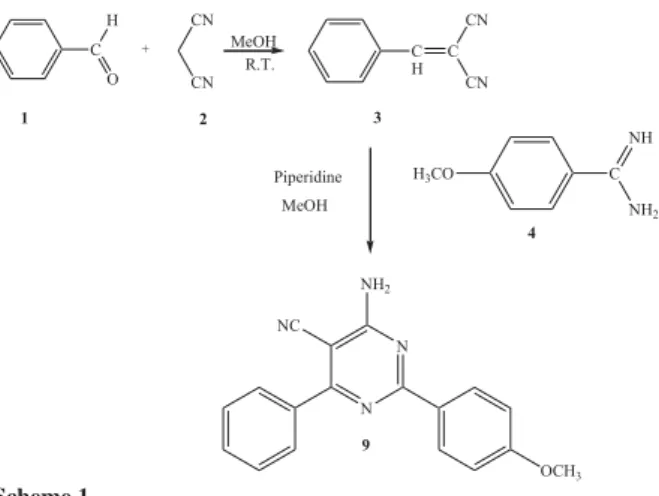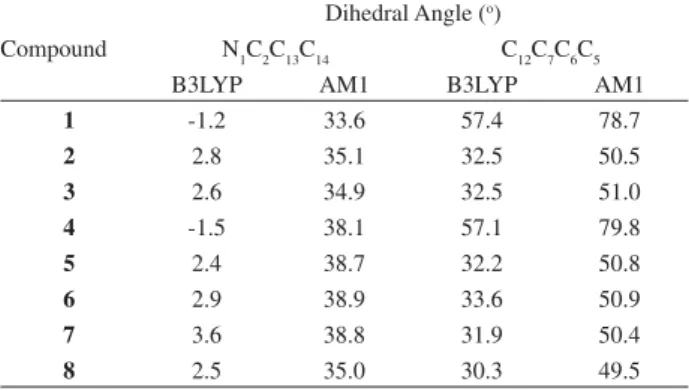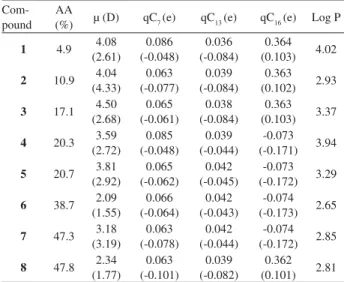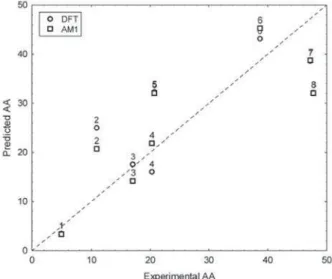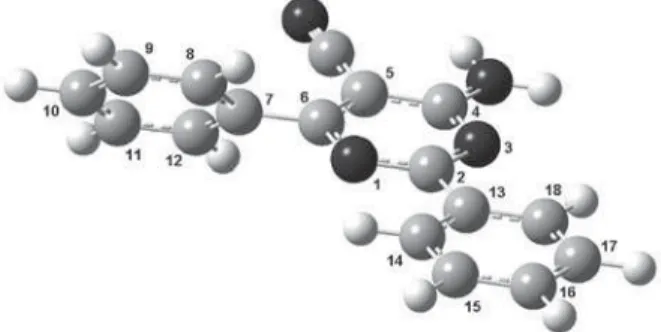Article
Printed in Brazil - ©2008 Sociedade Brasileira de Química0103 - 5053 $6.00+0.00
*e-mail: mramos@ufpe.br; melosebastiao@yahoo.com.br
Quantitative Structure-Activity Relationships (QSAR) of
4-Amino-2,6-diarylpyrimidine-5-carbonitriles with Anti-inflammatory Activity
João Bosco P. da Silva,
aMozart N. Ramos,*
,aBenício de Barros Neto,
aSebastião José de Melo,*
,bEmerson Peter da Silva Falcão
cand Maria Teresa J. de Almeida Catanho
da
Departamento de Química Fundamental, Universidade Federal de Pernambuco, 50740-540 Recife-PE, Brazil
b
Departamento de Antibióticos, Universidade Federal de Pernambuco, 50740-521 Recife-PE, Brazil
c
Centro Acadêmico de Vitória de Santo Antão, Universidade Federal de Pernambuco, 55608-680, Recife-PE, Brazil
d
Departamento de Biofísica e Radiobiologia, Universidade Federal de Pernambuco, 50670-901 Recife-PE, Brazil
As atividades antiinflamatórias de oito compostos 4-amino-2,6-diarilpirimidina-5-carbonitrilas foram sujeitas a uma análise QSAR baseada nos resultados de cálculos de estrutura eletrônica B3LYP/6-31G(d,p) e AM1. Análise de Componentes Principais e regressões baseados nesses dados indicam que compostos potencialmente mais ativos teriam menores valores de momentos de dipolo e de coeficientes de partição e também seriam afetados pelos valores de cargas dos átomos de carbono através dos quais os dois anéis aromáticos estão ligados ao anel pirimidínico. Duas novas moléculas foram previstas serem, ao menos, tão ativas como aquelas com as maiores atividades usadas no estágio de construção do modelo. Uma delas, tendo o grupo metoxila conectado a um dos anéis aromáticos, foi prevista ter um valor de atividade antiinflamatória de 52,3%. Essa molécula foi sintetizada e sua atividade experimental foi determinada em 52,8%, em concordância com a previsão teórica AM1. Esse valor é 5% maior que o maior valor usado para a modelagem.
The experimental anti-inflammatory activities of eight 4-amino-2,6-diarylpyrimidine-5-carbonitriles were subjected to a QSAR analysis based on results from B3LYP/6-31G(d,p) and AM1 electronic structure calculations. Principal component analyses and regressions based on these data indicate that potentially more active compounds should have low dipole moment and partition coefficient values and also be affected by the values of the charges of the carbon atoms through which the two aromatic rings are bonded to the pyrimidinic ring. Two new molecules were predicted to be at least as active as those with the highest activities used in the model building stage. One of them, having a methoxy group attached to one of the aromatic rings, was predicted to have an anti-inflammatory activity value of 52.3%. This molecule was synthesized and its experimental activity was found to be 52.8%, in agreement with the AM1 theoretical prediction. This value is 5% higher than the largest value used for modeling.
Keywords: pyrimidine derivatives, anti-inflammatory activity, molecular modeling, QSAR
Introduction
It is well known1-5 that heterocyclic compounds
containing pyrimidinic rings can present antifungal,1
antitumoral2 and anti-inflammatory action,3 among other
pharmacological activities. The pharmacological action is mainly observed when the amino group is bonded to
the pyrimidinic ring at the 2- and/or 4- positions.4 Kansy
et al.5 have synthesized new derivatives of
2,4-diamino-5-benzylpyrimidines, to evaluate their inhibitory activity against dihydrofolate reductase (DHFR), and observed that the inhibitory action against this enzyme is much larger than that of other conventional drugs, like sulfadiazine.
More recently, Gangjee et al.6 have also observed that two
series of nonclassical antifolates (2,4-diamino-5-deaza compounds and 5,10-dideaza compounds) are potent
Toxoplasma gondii (tg), which cause fatal opportunistic infections in AIDS patients.
These results have encouraged new investigations involving pyrimidinic derivatives with an amino group at position 4. In the past few years, Melo and collaborators have attempted to synthesize new pyrimidinic compounds
and evaluate their anti-inflammatory activities.7 Recently,
they have successfully synthesized a set of new
4-amino-2,6-diarylpyrimidine-5-carbonitriles,8 whose structures are
shown in Figure 1.
These derivatives have shown a significant anti-inflammatory activity (AA), as evaluated by their action on
carrageenan-induced mouse paw edema.9,10 They have also
presented low toxicity after intraperitoneal administration
to groups of ten Swiss adult albino mice (20-22 g).9,11 It has
been observed that their activities are drastically changed by modifications in the substituents bonded to positions 2
and 6 of the pyrimidinic ring. For instance, when the R2
group is a chlorine atom, as in compound 5, the drug’s
anti-inflammatory activity is 20.7%. If chlorine is substituted
by fluorine (compound 7), the anti-inflammatory action
increases to 47.3%, which is larger than the 36.5% value observed when the traditional acetylsalicylic acid (ASA) is administered at a dose of 250 mg/kg. On the other hand,
when a hydrogen atom at R1 is substituted by chlorine
(compounds 3 and 1), the anti-inflammatory activity is
reduced from 17.1% to 4.9%.
In an attempt to find out what structural modifications contribute to these pharmacological changes, we examined this series of
4-amino-2,6-diarylpyrimidine-5-carbonitriles,10 searching for a relation between the
experimentally determined anti-inflammatory activities and electronic parameters obtained from molecular orbital calculations. To validate the mathematical relationships obtained, we synthesized the most active compound predicted by the analysis and measured its anti-inflammatory activity.
Experimental
Synthesis
The starting 4-substituted benzaldehyde 1was allowed
to react with malononitrile 2, to produce the convenient
unsaturated bisnitrile 3. Condensation of that compound with
arilamidine in the presence of piperidine yielded
4-amino-6-(phenyl)-2-(p-anizyl)-5-cyano-pyrimidine (9). The synthetic
pathway leading to compound 9 is shown in Scheme 1.
Preparation of 4-amino-2-(phenyl) -6-(p-anizyl)-5-cyano-pyrimidine (9)
Bisnitrile (5.36 mmol) and arylamidine (5.36 mmol) were dissolved in methanol (20 mL) and refluxed for 7 h. The contents were cooled to room temperature and the solvent evaporated under reduced pressure to give a solid mass, which was cromatographed over silica gel. The
desired compound was eluted using a mixture of n-hexane/
ethyl acetate (4:1). The fractions containing compound 9
were combined, the solvent evaporated, and the product was crystallized in methanol.
Chemical analysis
The sample IR spectrum was recorded with a Bruker spectrometer model IFS 66 (Fourier Transform) utilizing KBr pellets. The EI mass spectrum was obtained with a Delsi-Nermag mass spectrometer, coupled to a GC (HP
5890) at an ionization potential of 70 eV. The 1H-NMR
spectrum was recorded with a 300 MHz Varian spectrometer model UNITY plus. The Melting point was obtained with an Electrothermal digital melting point apparatus (model 9100) and is uncorrected. Thin-layer chromatography was carried out on plates coated with silica gel containing the fluorescent indicator F254 and the spots were detected
Figure 1. Series of newly synthesized 4-amino-2,6-diarylpyrimidine-5-carbonitriles.
under ultraviolet light. The solvent system was ethyl acetate/hexane (4:1).
4-Amino-2-(phenyl) -6-(p-anizyl)-5-cyano-pyrimidine (9)
This compound was obtained as white crystals with a
yield of 54.6%; mp 214-215 °C; Rf= 0.39 (n-hexane/ethyl
acetate, 8:2); (KBr, Nmax/cm-1): 3475 (NH
2 asymm), 3343
(NH2 symm), 2217 (CN), 1638 (C=N); 1H-NMR: (DMSO-d 6,
300 MHz), D 8.38 (m, 2H, J= 9.0 Hz, H2’, H6’), 7.12 (d,
2H,J9.0 Hz, H3’’, H5’’), 7.72 (sL, 2H, NH2), 8.0 (d, 2H,
J8.7 Hz, H2’’, H6’’), 7.52 (m, 3H, J8.1 Hz, H3’, H5’, H4’),
3.84 (s, 3H, CH3O), MS: m/z (rel. int.) 317 (M+, 100),
318 (49.66). Anal. Calculated for C18H14N4O.1/4H2O: C,
61,44%; H, 3.86%; N, 19.90%. Found: C, 61.40%; H, 3.75%; N, 19.96%.
Methods
Software
To obtain the electronic properties of the compounds considered in this work, quantum-chemical calculations were performed at two levels, with the GAUSSIAN 94
program:12 (i) semi-empirical AM113 and (ii) Density
Functional Theory (DFT)14 using the hybrid functional
B3LYP15 with a 6-31G(d,p) basis set.16 All statistical
calculations were carried out with the Statistica 6.1
software.17 Octanol/water partition coefficient values
were estimated with the Kowwin v1.67 program.18 All
calculations were performed on a PC (Pentium III, 800 MHz, 512MB RAM, 30GB HD).
Pharmacology
The anti-inflammatory assays were preceded by acute toxicity tests in mice. The pyrimidine derivatives were individually dissolved in a prepared 2.5% Tween 80 solution diluted in 0.9% saline water. Intraperitoneal administration of this suspension (0.5 mL) to the animals at doses of 125,
250, 500 and 1000 mg kg-1 of body weight did not show
any toxic effects after 4-72 hours waiting periods. Anti-inflammatory tests were performed for the
compounds shown in Figure 1, using 250 mg kg-1doses in
groups of 10 Swiss albino mice. All the compounds exhibited anti-inflammatory activity, ranging from 4.9% to 47.8%.
Calculations
The molecular geometry of each compound was fully optimized at both calculation levels and no imaginary
frequency was observed. From these calculations we determined the frontier orbital energy values, Mulliken net charges, molecular electric dipole moments and the
molar volume (Vm) for all studied molecules. Initially,
the molecular geometry of the parent compound (6) with
R1= R2= R3 = H was fully optimized. In this procedure,
the N1C2C13C14and C12C7C6C5 dihedral angles between the aromatic rings and the pyrimidinic ring were allowed to vary. After optimization, however, the B3LYP/6-31G(d,p)
calculations revealed that the N1C2C13C14angle is close
to zero, i.e., the aromatic ring containing the R3 group
is practically on the same plane of the pyrimidinic ring, in contrast to what happens with the other aromatic ring. The optimized dihedral angles for the eight structures are given in Table 1.
The B3LYP/6-31G(d,p) value of the dihedral angle
C12C7C6C5 is close to 30o for most compounds, but increases
to about 57o in compounds 1 and 4, for which R1 = Cl. The
same pattern is observed in the AM1 results, except that the values are now all higher than the corresponding B3LYP angles. However, the AM1 calculations show that the most stable conformation corresponds to a minimum energy structure in which both aromatic rings are non-planar to the pyrimidinic ring. For the six compounds without a chlorine
atom at R1, the N
1C2C13C14 and C12C7C6C5 AM1 dihedral
angle variation is slight: 34-38n and 49-51°, respectively.
Introduction of a chlorine atom at R1 (compounds 1 and 4)
increases the C12C7C6C5 dihedral angle to about 79n.
A set of basic descriptors was used in regressions to predict the anti-inflammatory activity of the compounds. Some of the electronic descriptors are highly correlated among themselves, which could cause statistical instability in the ordinary multiple regression equations due to multicollinearity. Therefore, we first performed a principal
Table 1. B3LYP/6-31G(d,p) and AM1 values of the N1C2C13C14 and C12C7C6C5 dihedral angles for the fully optimized minimum energy structures of the 4-amino-2,6-diarylpyrimidine-5-carbonitriles shown in Figure 1
Compound
Dihedral Angle (o)
N1C2C13C14 C12C7C6C5
B3LYP AM1 B3LYP AM1
1 -1.2 33.6 57.4 78.7
2 2.8 35.1 32.5 50.5
3 2.6 34.9 32.5 51.0
4 -1.5 38.1 57.1 79.8
5 2.4 38.7 32.2 50.8
6 2.9 38.9 33.6 50.9
7 3.6 38.8 31.9 50.4
component analysis (PCA) on them, and regressed the dependent variable, AA, on the scores obtained from the PCA, instead of on the descriptors themselves.
In a principal component analysis, the original data matrix is projected onto a subspace defined by linear combinations of the original variables with maximum variance – that is, maximum information – and orthogonal
to each other.19 The first principal component (PC1) is
the axis describing the maximum possible variance in the original multidimensional space; the second component is orthogonal to PC1 and describes the maximum variance not already described by PC1, and so on. The orthogonality between different PC axes eliminates the regression multicollinearity problem.
Each principal component is characterized by three
mathematical entities: (i) the percent amount of explained
variance; (ii) a loadings vector, whose elements are
the cosines of the angles the PC axis forms with the
original variable axes; (iii) a scores vector, containing
the coordinates locating the individual compounds in the PC axis. A regression on the scores of a PCA is called a
principal component regression.20
Results and Discussion
The B3LYP and AM1 descriptors having absolute correlation coefficients with the AA values larger
thanca. 0.4, were selected for the regression step. These,
together with log P, which has a correlation coefficient of −0.70 with the anti-inflammatory activity, form the set of descriptors for each pyrimidinic derivative. Their values for the eight compounds are given in Table 2.
A principal component analysis based on the correlation matrix of the five descriptors was carried out, using the DFT calculated values. The loadings plot of first two components, which together account for 86% of the total information, is shown in Figure 2(a). The anti-inflammatory activity is also projected on this plot, but was not used in the PCA calculations. It almost exactly coincides with the positive side of the PC1 axis. On the
same side, and close to AA, is qC13, whereas the other
four descriptors have negative loadings on PC1. This means that high anti-inflammatory values are expected to
be associated with high qC13 values and with low values
of the other four descriptors. The corresponding scores plot is shown in Figure 2(b). Overall, the more active compounds have more positive scores on PC1. The least
active compound 1 has the most negative PC1 score. The
score on the first component, therefore, can be interpreted as a composite theoretical measure of anti-inflammatory activity.
A regression of the AA values on the PC1 scores yields the equation
AA = 25.96(±3.80) + 7.61(±2.35)t1, (1)
With R2 = 0.64, F
1,6 = 10.46 and p = 0.018, where
t1 stands for the score on the PC1 axis. The values in
parentheses are the standard error estimates of the
regression coefficients. Though the R2 value is not very
impressive, both coefficients are statistically significant at the 95% confidence level.
When the same analysis is performed with AM1 descriptors, the PCA results are slightly different. The loadings plot is shown in Figure 3. The information reproduced by the first two PCs is 82%, almost the same as when the DFT descriptors were used, but high anti-inflammatory activities now appear to be associated with negative scores on PC2. A regression of the AA values on these scores results in the equation
AA = 25.96(±3.54) – 9.75(±2.71)t2, (2)
With R2 = 0.68, F
1,6 = 12.97 and p = 0.011. Both
coefficients are again significant, and the negative sign for
the t2 coefficient indicates that highly positive scores on the
second principal component are expected to be associated with poor anti-inflammatory activities, as already suggested by the loadings plot. Moreover, the pattern of the variable loadings along PC2 is strikingly similar to the one observed along PC1 with the DFT values.
Despite the difference in the PCA results, both regressions yield very similar predictions for the AA values,
Table 2. Anti-inflammatory activities (AA) and B3LYP/6-31G(d,p) and AM1 electronic parameters for the 4-amino-2,6-diarylprymidine-5-carbonitriles in Figure 1. AM1 values are given in parentheses
Com-pound AA
(%) µ (D) qC7(e) qC13(e) qC16(e) Log P
1 4.9 4.08
(2.61) 0.086 (-0.048) 0.036 (-0.084) 0.364 (0.103) 4.02
2 10.9 4.04
(4.33) 0.063 (-0.077) 0.039 (-0.084) 0.363 (0.102) 2.93
3 17.1 4.50
(2.68) 0.065 (-0.061) 0.038 (-0.084) 0.363 (0.103) 3.37
4 20.3 3.59
(2.72) 0.085 (-0.048) 0.039 (-0.044) -0.073 (-0.171) 3.94
5 20.7 3.81
(2.92) 0.065 (-0.062) 0.042 (-0.045) -0.073 (-0.172) 3.29
6 38.7 2.09
(1.55) 0.066 (-0.064) 0.042 (-0.043) -0.074 (-0.173) 2.65
7 47.3 3.18
(3.19) 0.063 (-0.078) 0.042 (-0.044) -0.074 (-0.172) 2.85
8 47.8 2.34
as can be visualized in Figure 4, where the predicted values are plotted against the experimental ones. Where only one
number appears, as for compounds 1 and 7, for example, the
predictions are so close that their points in the plot overlap. The corresponding numerical values are given in Table 3.
An AM1 conformational analysis on the parent
compound6 (R1 = R2 = R3 = H) revealed the existence of
other stable conformations corresponding to minimum
energy values, caused by rotation of the C6-C7 and C2-C13
bonds. This led us to investigate the possible influence of the conformational effect on the QSAR regression model. The most stable conformation using the B3LYP
calculations indicates that the N1C2C13C14 dihedral angle
is close to zero, that is, the aromatic ring containing the R3
group and the pyrimidinic ring are practically on the same
Figure 2. Results of the principal component analysis performed on the DFT results plus logP. (a) Loadings plot. (b) Scores plot. The percent information reproduced by each component is given in the respective axis title.
Figure 3. Loadings plot for the PCA carried out on the AM1 results plus logP.
Figure 4. Plot of the B3LYP/6-31G(d,p) and AM1 predicted anti-inflammatory activities against the experimental activities.
Table 3. Experimental and predicted values obtained from equations (1) and (2) for the anti-inflammatory activities of the 4-amino-2,6-diarylpy-rimidine-5-carbonitriles in Figure 1
Compound AAExptl(%) AAPred, B3LYP (%) AAPred, AM1 (%)
1 4.9 3.4 3.3
2 10.9 24.8 20.6
3 17.1 17.3 14.1
4 20.3 16.2 21.7
5 20.7 32.3 32.0
6 38.7 43.1 45.2
7 47.3 38.6 38.7
plane, whereas the C12C7C6C5 dihedral angle is non planar. This conformation also corresponds to an AM1 minimum energy structure, which is shown in Figure 5.
The electronic indices corresponding to this conformation were calculated for all the pyrimidinic derivatives studied. All calculations, from the correlation matrix to the principal component regression were repeated with the new AM1 results. The conclusions were the same as those reached with the fully optimized AM1 values. In particular, the regression equation is almost identical to equation 2. This indicates that the AM1 regression model is statistically robust with respect to conformational changes.
New anti-inflammatory agents. The principal component analyses suggest that to obtain higher AA values one should try to synthesize molecules having lower logP, dipole
moment and qC7 values, and higher qC13 values. Using these
criteria, we designed two new compounds expected to be more active than those used for model building.
Introducing an electron-donor species such as a
methoxy group at R2, that is, at the para position of the
aromatic ring bonded to the pyrimidinic ring at position 6, the molecular dipole moment should be reduced and
the atomic charge of C7 should become more negative (or
less positive), and consequently the anti-inflammatory activity of these pyrimidinic derivatives should be enhanced. Based on these considerations, we performed
B3LYP6-31G(d,p) and AM1 calculations for
4-amino-2,6-diarylpyrimidine-5-carbonitriles with a methoxy or an
Table 4. Anti-inflammatory activities and B3LYP and AM1 electronic parameters for the two proposed compounds. PCA scores are given in the last column. AM1 values are given in parenthesis, and correspond to the score on PC2a
Compoundb AA
Exptl(%) AAPred(%) µ (D) qC7(e) qC13(e) qC16 (e) logP PCA Score
9 52.8 48.1 (52.3 ) 0.82 (1.42) 0.063 (-0.113) 0.042 (-0.052) -0.074 (-0.173) 2.73 2.91 (-2.70)
10 - 44.6 (48.4) 0.86 (1.23) 0.062 (-0.115) 0.042 (-0.052) -0.074 (-0.173) 3.22 2.45 (-2.30)
aB3LYP and AM1 predicted activities were calculated from equations (1) and (2), respectively; b9: R1 = R3 = H , R2 = OCH
3; 10: R
1 = R3 = H,
R2 = OC
2H5.
Figure 5. AM1 conformational structure for compound 6, in which the aromatic ring containing the R3 group and the pyrimidinic ring are on
the same plane.
ethoxy group at R2. The results for the new compounds,
9 (R2 = methoxy) and 10 (R2 = ethoxy) are shown in
Table 4. As expected, their dipole moments are much lower than those calculated for the compounds used to estimate the regression equations. The other variables follow the same favorable pattern, except for logP, which does not decrease much. Projecting these values in the PC1×PC2 planes defined by the loadings calculated with the modeling data, the scores of the new compounds can be calculated, yielding the values in the last column of Table 4. Feeding these scores into the regression equations resulted in the predicted activities shown in the same table,
which indicate that compounds 9 and 10 should be at least
as strong anti-inflammatory agents as the strongest ones used to calculate equations (1) and (2).
Following previously described experimental
procedures,8,21,22 we successfully synthesized compound
9, which has a methoxy group at R2. Its anti-inflammatory
activity was then evaluated following experimental
procedures also described in the literature.9,10 The
experimental value, 52.8%, almost matches the AM1 predicted value, 52.3%, and is about 5% larger than the anti-inflammatory activity of the most effective pyrimidinic derivative used in the model building phase. This lends support to predictive power of the PCR equations, despite
their relatively low R2 values.
Conclusion
The molecular modeling and the statistical analyses reported in this work indicate that the anti-inflammatory activity of 4-amino-2,6-diarylpyrimidine-5-carbonitriles might be related to the molecular dipole moment and to the atomic charges of the carbon atoms through which the aromatic rings are attached to the pyrimidinic ring.
Compounds with lower logP, dipole moment and qC7 values
and higher qC13 values are expected to be more active. Two
Acknowledgments
This work is dedicated to Professor Ricardo de Carvalho
Ferreira on the occasion of his 80th birthday. Prof. Ricardo
is for many reasons an inspiration for Brazilian scientists, among which we could cite his pioneering work in theoretical quantum chemistry and evolutionary biology. His example as an educator and a human being cannot be surmised from his many publications. We also gratefully acknowledge financial support from the Brazilian agencies CNPq, FINEP and CAPES.
References
1. Anderson, G. W.; Halverstadt, I. F.; Miller, W. H.; Rohlin, R. O.;J. Am. Chem. Soc.1954,67, 2197.
2. Heidelberger, C.; Chaudhuri, N. C.; Dannber, P.; Mooren, D.; Griesbach, L.; Duchinsky, R.; Schnitzer, R. J.; Pleven E.; Scheiner, J.; Nature1957,179, 663.
3. Sandanandam, Y. S.; Shetty, M. M.; Diwan, P. V.; Eur. J. Med. Chem.1992,27, 87.
4. Fischl, M. A.; Dickinson, G. M.; Voie, L.; J. Am. Med. Assoc.
1988,259, 1185; Leport, C.; Raffi, R.; Metheron, S.; Katiama,
C.; Regnier, B.; Simot, A. G.; Marche, C.; Vederenne, C.; Vilde, J. L.; Am. J. Med.1988,84, 94; Allegra, C. J.; Kovacs, A. J.; Drake, J. C.; Swan, J. C.; Chabner, B. A.; Mansur, H.; J. Clin.
Invest.1987,79, 478.
5. Kansy, M.; Seydel, J. K.; Wiese, M.; Haller, R.; Eur. J. Med. Chem.1992,27, 237.
6. Gangjee, A.; Devraj, R.; McGuire Queener, S. F.; J. Med. Chem.
1997,40, 470.
7. Melo, S. J.; Luu-Duc, C.; Thomassom, F.; Narcise, G.; Gaultier, C. ;Ann. Pharm. Fr.1992,50, 39.
8. de Melo, S. J.; dos Santos, L. C.; Falcão, E. P. D.; Srivastava, R. M.; Luu-Duc, C.; J. Chem. Res. (S)2002,5, 216.
9. Falcão, E. P. S.; PhD Thesis, Universidade Federal de Pernambuco, Recife, Brazil, 2003.
10. Falcão, E. P. S.; Melo, S. J.; Srivastava, M. R.; Jansen, M. T. A. C.; Nascimento, S. C.; Eur. J. Med. Chem.2006,41, 276. 11. G. Karber; B. Behrens; Statistical Methods in Biological Assay;
2nd ed., London: Charles Griffin, 1964.
12. Frisch, M. J.; Trucks, G. W.; Schlegel, H. B.; Gill, P. M. W.; Johnson, B. G.; Robb, M. A.; Cheeseman, J. R.; Keith, T.; Petersson, G. A.; Montgomery, J. A.; Raghavachari, K.; Al-Laham, M. A.; Zakrzewski, V. G.; Ortiz, J. V.; Foresman, J. B.; Cioslowski, J.; Stefanov, B. B.; Nanayakkara, A.; Challacombe, M.; Peng, C. Y.; Ayala, P. Y.; Chen, W.; Wong, M. W.; Andres, J. L.; Replogle, E. S.; Gomperts, R.; Martin, R. L.; Fox, D. J.; Binkley, J. S.; Defrees, D. J.; Baker, J.; Stewart, J. P.; Head-Gordon, M.; Gonzalez, C.; Pople, J. A.; Gaussian 94, Revision E.3; Gaussian, Inc., Pittsburgh PA, 1995.
13. Dewar, M. J. S.; Zoebisch, E. G.; Healy, E. F.; J. Am. Chem. Soc.1985,107, 3902.
14. Hohenberg, P.; Kohn, W.; Phys. Rev.1964,136, B864. 15. Becke, A. D.; J. Chem. Phys.1993,98, 5648.
16. Frisch, M. J.; Pople, J. A.; Binkley, J. S.; J. Chem. Phys.1984,
80, 3265.
17. STATISTICA (data analysis software system); version 6.1, StatSoft, Inc.; www.statsoft.com, 2004.
18. Program KwwinTM v.1.67, U.S. Environmental Protection
Agency, 2000.
19. Jolliffe, I. T.; Principal Component Analysis, 2nd ed., Springer:
New York, 2002.
20. Naes, T.; Isaksson, T.; Fearn, T.; Davies, T.; A User-friendly Guide to Multivariate Calibration and Classification, NIR
Publications, Chichester: UK, 2002.
21. Hussain, S. M.; El-Reedy, A. M.; El-Sharabasy, S. A.;
Tetrahedron1988,44, 241.
22. Nicicolle, E. J.; PhD Thesis, L’Université Joseph Fourier, Grenoble, France, 1990.
Received: August 22, 2007
